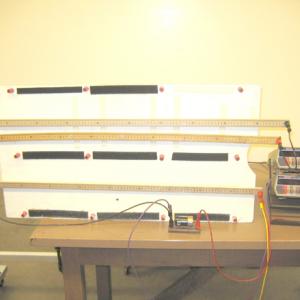College of Liberal Arts & Sciences
5D10.20 - Resistance vs. Diameter, Resistance vs. Length
The resistance board show resistance vs diameter and resistance vs length with copper and nichrome wires using a multimeter to measure Ohms. Note that the diameters of the wires double for each step as you go from smallest to largest diameter.
A variation is to use a 3 Volt battery and measure the currents through the same length, same diameter, of copper and nichrome wires. You can also show that the current increases as the diameter of the wire increases quite easily as the diameters of the wires on the board double for each step as you go from smallest to largest diameter. Note that if you monitor the voltage you will be able to show there is significant circuit loading as the diameter of the wires increase.
Series and parallel measurements can be made with linear wire resistors that are on the meter sticks.
- Asuman Kucukozer, "Teaching the Factors Affecting Resistance Using Pencil Leads", TPT, Vol. 53, # 1, Jan. 2015, p. 38.
- "Figuring Physics", TPT, Vol. 50, # 5, May 2012, p. 264.
- Joseph Frick, "# 309 - Conducting Power and Ohm's Law", Physical Technics: Or Practical Instructions for Making Experiments in Physics and the Construction of Physical Apparatus with the Most Limmited Means, p. 365.
Disclaimer: These demonstrations are provided only for illustrative use by persons affiliated with The University of Iowa and only under the direction of a trained instructor or physicist. The University of Iowa is not responsible for demonstrations performed by those using their own equipment or who choose to use this reference material for their own purpose. The demonstrations included here are within the public domain and can be found in materials contained in libraries, bookstores, and through electronic sources. Performing all or any portion of any of these demonstrations, with or without revisions not depicted here entails inherent risks. These risks include, without limitation, bodily injury (and possibly death), including risks to health that may be temporary or permanent and that may exacerbate a pre-existing medical condition; and property loss or damage. Anyone performing any part of these demonstrations, even with revisions, knowingly and voluntarily assumes all risks associated with them.
